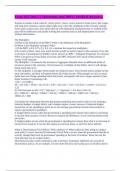Exam (elaborations)
Econ 203 Test 2 || Questions and 100% Verified Answers.
- Course
- Institution
Explain in simple words what do "sticky prices" mean. correct answers Some prices, like wages and long term contracts, cannot adjust right away when the conditions in the economy change. Since prices cannot react, that means that the self-adjustment mechanism that we studied in the past will be ine...
[Show more]



